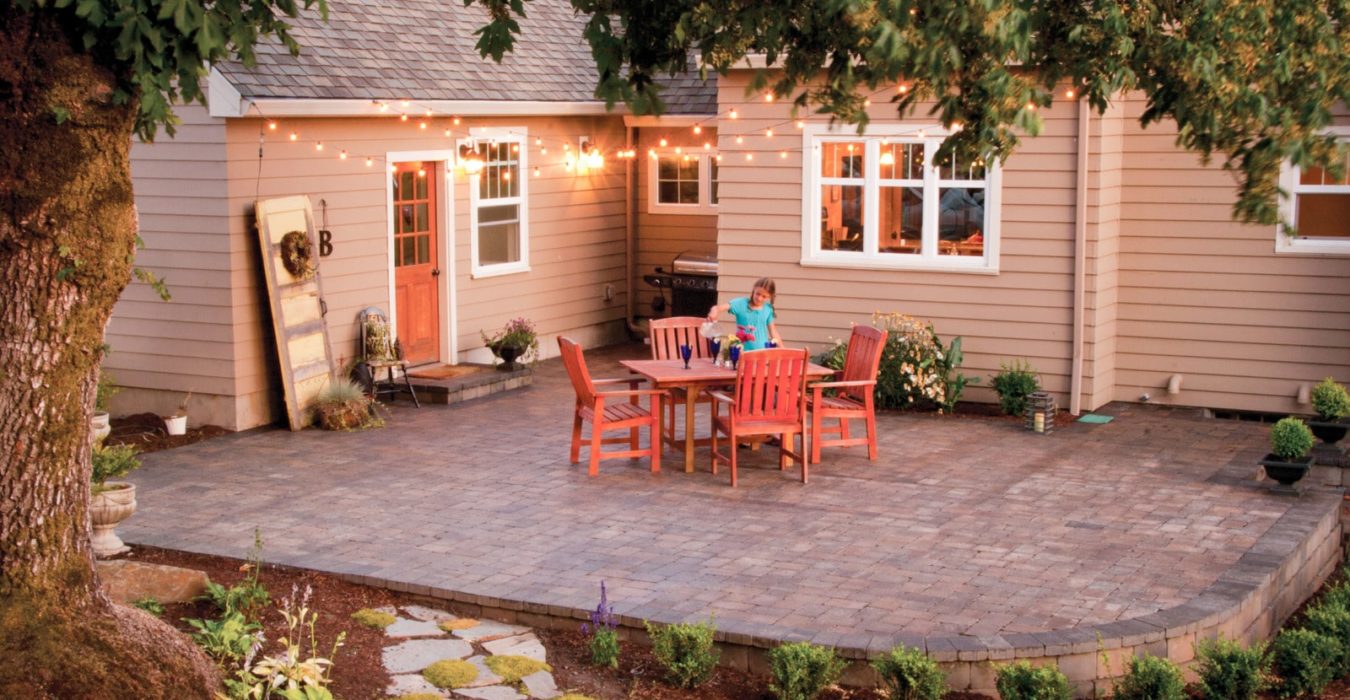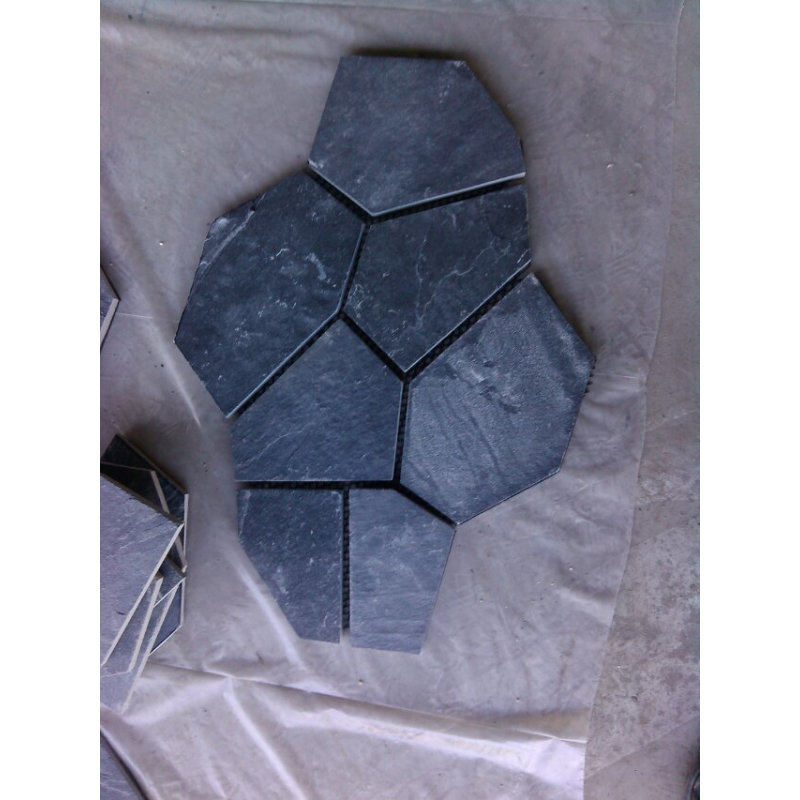As a disclaimer, we manufacture and sell paving stones, so we have a biased opinion. However, we aim to present both sides clearly while sharing why you should consider pavers for your next project—and how we can help.
Let’s get to it. In the points below, we’re going to explore how concrete and pavers compare in the categories of drainage, durability, beauty, repairs, and value.
耐用性
Whether you install concrete or pavers, you’ll want a product that will stand the test of time. Consider the wear and tear of foot traffic, bike traffic, car traffic, or extreme weather conditions.
秋玫瑰天然石板垫
具体的
Concrete is durable. There’s no doubt! However, one common problem is cracking in cold weather. Elements like moisture and temperature often cause concrete to expand and contract, leading to cracking.
Concrete production standards require it to have a much lower ASTM (American Society for Testing and Materials) specification than pavers. Specifically, poured concrete is made to a compressive strength of 2,500–3,000 PSI while pavers are made to a minimum compressive strength of 8,000 PSI. In simple terms, concrete is less than half as dense as pavers.
This means that concrete is more likely to absorb water than displace it, which causes cracking when the air reaches freezing temperatures.
When your concrete cracks, you’ll want to repair it. Except, it isn’t easy to repair concrete without a band-aid approach. You typically have to start over and pour a fresh slab. We’ll explain repairs a bit more later.
Pavers
Pavers are a lot less likely to crack because of the aggregate mix and their method of interlock. The natural density of the stone—created by the high compressive strength—doesn’t allow water to enter the stone in the first place.
Specifically, our pavers are made with less than 5% water absorption—which means they’re so dense that moisture barely permeates the pavers themselves at all. This means that cracking due to moisture absorption is virtually impossible.
A hardscape will still expand and contract as seasons change. However, the sand joints and natural interlock between pavers allows plenty of room for them to expand and contract without cracking.
Drainage
If you live in a climate like the Pacific Northwest, consider how your project will handle water drainage. You certainly don’t want any water to drain towards your house or down your driveway into your garage. You also don’t want low spots that encourage substantial puddling.
具体的
When wet, concrete acts similar to a sponge (albeit much less porous). For example, if you spill water on a concrete surface, it makes a wet spot instead of a puddle. Since concrete is porous, it absorbs as much moisture as it can until it reaches its limit. Once it can’t retain any more moisture, it will either puddle or drain.
The best way to encourage water drainage on concrete is to grade your concrete accurately. However, if you set the grade in the wrong direction or lay the base is uneven, concrete can create puddles.
Pavers
Pavers are made to drain and displace water. As we discussed in the last point about durability, they’re extremely dense and don’t retain water. Instead, they disperse and permeate water through their sand-filled joints.
You can also install permeable pavers to direct heavy rainfall back into the ground. Permeable pavers have a few unique features that make them even better for water drainage: smaller stones, larger joints, and an open-graded rock base. Consider using pavers, if not permeable pavers, if you’re concerned about water drainage for your project.
Repairs
We’ve already established that pavers and concrete can both develop issues and will eventually need repair. Additionally, sometimes repairs to plumbing or utilities need to be done below the paved surface. When that happens, can you repair the existing hardscape, or do you need to tear it up and start over? If you can make a repair, will it show? Let’s explore how concrete and pavers both stand up to repair situations.
具体的
To repair concrete, you typically have to chip away any broken pieces and patch the area. You can do this with an epoxy compound, latex patching material, or mortar mix. Unfortunately, concrete rarely looks like it did before the repair.
As you can see above in the image of the sidewalk, the concrete chipped and someone attempted to patch it back together. Some compound still remains on the edges, however, the concrete is missing. The only way to fix this issue is to break apart the sidewalk and pour an entirely new section.
Pavers
Pavers are much easier to repair than concrete. To repair paving stones, you need to pull up the problem area (and sometimes the surrounding stones), adjust the base, and re-lay the stones.
Fortunately, removing and replacing pavers is quite easy and requires a couple of hand tools and a short amount of time. Plus, your pavers will look the same as they did before the repair—if not better.
If you want to learn more about what it takes to repair pavers, watch one of our step-by-step tutorials on the four of the most common hardscape repairs: How to Remove Tree Roots Under Pavers, How to Fix a Failed Edge, How to Repair Sinking Patio Pavers, and How to Remove and Replace a Paver.
应用
Most people that do home renovation projects do so for two reasons: beauty and utility. A new walkway to your front door, new patio in your backyard, or a new driveway has to solve a practical need 和 a visual one. Let’s explore how decorative concrete and pavers are.
具体的
Concrete can be stunning, particularly when polished, sealed with a glossy finish, or stamped with a texture that resembles brick, slate, flagstone, stone, tile, and wood.
The image above depicts exposed aggregate concrete; down the middle of the driveway is a typical concrete slab. On the right side, near the bushes, they used a larger stone mix to give the concrete some character.
If you don’t stamp, polish, or texture your concrete, it can look more like a helicopter pad than a living space. It’s practical and easy to maintain; it’s just flat and contains little to no inherent beauty. Unless you stain your concrete, you’re limited to the same dull grey color.
Pavers
Paving stones have (almost) endless design options, shapes, and colors. There are many styles of pavers that you can use to match your taste and complete any hardscape project. You can also install pavers in a variety of patterns and styles like smooth, rustic, cobbled, and textured. Each has a unique look and feel.
Regarding paver colors, you can choose from light grey, dark grey, tan, brown, and red. You can combine the individual colors into a variety of blends that bring everything together. Not to mention, our color mixture saturates the entire paver—inside and out—so the color will last a long time.
Most importantly, pavers can be walked-on immediately after installed, where concrete requires cure time. Not to mention, it can take longer to properly pour a concrete pad than lay a paver patio. This is especially true for small projects.
Value
No matter how useful, beautiful, or long-lasting a product can be, the decision to use it always depends on value. Which is the most cost-effective? Which improves the value of your property? Lastly, which do you prefer the most?
具体的
Concrete is consistently known to be cheaper than pavers. There’s no doubt about it. However, if you add color staining and stamping, the cost begins to rise quickly to be comparable to pavers.
The long-term value of concrete can vary depending on the person living in the home. Still, any hardscape typically increases value. Think about it. Would you rather have a gravel driveway or a paved one? How about a patio? What about a walkway? The answer is obvious. Everyone loves the cleanliness that a concrete patio, driveway, or walkway provides.
Pavers
Paving stones typically cost more than concrete initially. However, we’ve seen that over time they make up the difference. Here’s why: they’re easy to maintain, cheaper to repair, and they typically have a longer life.
Additionally, installing paving stones adds significant value to your home. If you have to sell your home, your investment will only add to the value of the deal.









